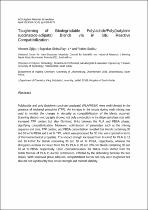 ResearchSpace
ResearchSpace
Toughening of biodegradable polylactide/poly(butylene succinate-co-adipate) blends via in situ reactive compatibilization
JavaScript is disabled for your browser. Some features of this site may not work without it.
- ResearchSpace
- →
- Research Publications/Outputs
- →
- Journal Articles
- →
- View Item
| dc.contributor.author |
Ojijo, Vincent O

|
|
| dc.contributor.author |
Ray, Suprakas S

|
|
| dc.contributor.author |
Sadiku, R

|
|
| dc.date.accessioned | 2013-11-27T11:54:53Z | |
| dc.date.available | 2013-11-27T11:54:53Z | |
| dc.date.issued | 2013-04 | |
| dc.identifier.citation | Ojijo, V., Ray, S.S. and Sadiku, R. 2013. Toughening of biodegradable polylactide/poly(butylene succinate-co-adipate) blends via in situ reactive compatibilization. ACS Applied Materials & Interfaces, vol. 5(10), pp 4266-4276 | en_US |
| dc.identifier.issn | 1944-8244 | |
| dc.identifier.uri | http://pubs.acs.org/doi/ipdf/10.1021/am400482f | |
| dc.identifier.uri | http://hdl.handle.net/10204/7103 | |
| dc.description | Copyright: 2013 ACS Publications. Ths is an ABSTRACT ONLY. The definitive version is published in ACS Applied Materials & Interfaces, vol. 5(10), pp 4266-4276 | en_US |
| dc.description.abstract | Polylactide and poly(butylene succinate-coadipate) (PLA/PBSA) were melt-blended in the presence of triphenyl phosphite (TPP). An increase in the torque during melt mixing was used to monitor the changes in viscosity as compatibilization of the blends occurred. Scanning electron micrographs showed not only a reduction in the dispersed-phase size with increased TPP content but also fibrillated links between the PLA and PBSA phases, signifying compatibilization. Moreover, optimization of parameters such as the mixing sequence and time, TPP content, and PBSA concentration revealed that blends containing 30 and 10 wt % PBSA and 2 wt % TPP, which were processed for 30 min, were optimal in terms of thermomechanical properties. The impact strength increased from 6 kJ/m2 for PLA to 11 and 16 kJ/m2 for blends containing 30 and 10 wt % PBSA, respectively, whereas the elongation-at-break increased from 6% for PLA to 20 and 37% for blends containing 30 and 10 wt % PBSA, respectively. Upon compatibilization, the failure mode shifted from the brittle fracture of PLA to ductile deformation, effected by the debonding between the two phases. With improved phase adhesion, compatibilized blends not only were toughened but also did not significantly lose tensile strength and thermal stability. | en_US |
| dc.language.iso | en | en_US |
| dc.publisher | American Chemical Society | en_US |
| dc.relation.ispartofseries | Workflow;11807 | |
| dc.subject | Polylactide/poly(butylene succinate-co-adipate) blends | en_US |
| dc.subject | Compatibilization | en_US |
| dc.subject | Toughening | en_US |
| dc.subject | Triphenyl phosphite | en_US |
| dc.title | Toughening of biodegradable polylactide/poly(butylene succinate-co-adipate) blends via in situ reactive compatibilization | en_US |
| dc.type | Article | en_US |
| dc.identifier.apacitation | Ojijo, V. O., Ray, S. S., & Sadiku, R. (2013). Toughening of biodegradable polylactide/poly(butylene succinate-co-adipate) blends via in situ reactive compatibilization. http://hdl.handle.net/10204/7103 | en_ZA |
| dc.identifier.chicagocitation | Ojijo, Vincent O, Suprakas S Ray, and R Sadiku "Toughening of biodegradable polylactide/poly(butylene succinate-co-adipate) blends via in situ reactive compatibilization." (2013) http://hdl.handle.net/10204/7103 | en_ZA |
| dc.identifier.vancouvercitation | Ojijo VO, Ray SS, Sadiku R. Toughening of biodegradable polylactide/poly(butylene succinate-co-adipate) blends via in situ reactive compatibilization. 2013; http://hdl.handle.net/10204/7103. | en_ZA |
| dc.identifier.ris | TY - Article AU - Ojijo, Vincent O AU - Ray, Suprakas S AU - Sadiku, R AB - Polylactide and poly(butylene succinate-coadipate) (PLA/PBSA) were melt-blended in the presence of triphenyl phosphite (TPP). An increase in the torque during melt mixing was used to monitor the changes in viscosity as compatibilization of the blends occurred. Scanning electron micrographs showed not only a reduction in the dispersed-phase size with increased TPP content but also fibrillated links between the PLA and PBSA phases, signifying compatibilization. Moreover, optimization of parameters such as the mixing sequence and time, TPP content, and PBSA concentration revealed that blends containing 30 and 10 wt % PBSA and 2 wt % TPP, which were processed for 30 min, were optimal in terms of thermomechanical properties. The impact strength increased from 6 kJ/m2 for PLA to 11 and 16 kJ/m2 for blends containing 30 and 10 wt % PBSA, respectively, whereas the elongation-at-break increased from 6% for PLA to 20 and 37% for blends containing 30 and 10 wt % PBSA, respectively. Upon compatibilization, the failure mode shifted from the brittle fracture of PLA to ductile deformation, effected by the debonding between the two phases. With improved phase adhesion, compatibilized blends not only were toughened but also did not significantly lose tensile strength and thermal stability. DA - 2013-04 DB - ResearchSpace DP - CSIR KW - Polylactide/poly(butylene succinate-co-adipate) blends KW - Compatibilization KW - Toughening KW - Triphenyl phosphite LK - https://researchspace.csir.co.za PY - 2013 SM - 1944-8244 T1 - Toughening of biodegradable polylactide/poly(butylene succinate-co-adipate) blends via in situ reactive compatibilization TI - Toughening of biodegradable polylactide/poly(butylene succinate-co-adipate) blends via in situ reactive compatibilization UR - http://hdl.handle.net/10204/7103 ER - | en_ZA |





